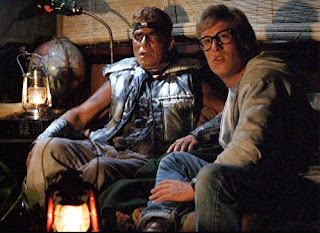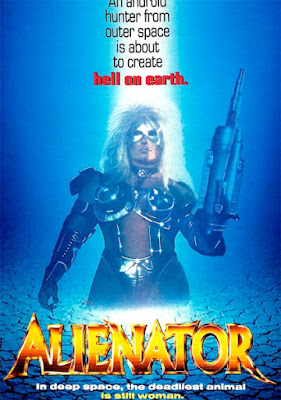Now Playing: Alienator (1990)
Pros: Cast features an intriguing selection of action and horror stars of the past; The concept of a female cyborg assassin is a nice twist.
Cons:Several of the veteran actors are wasted; Too many storylines and character backstories slow down the action.
Pros: Cast features an intriguing selection of action and horror stars of the past; The concept of a female cyborg assassin is a nice twist.
Cons:Several of the veteran actors are wasted; Too many storylines and character backstories slow down the action.
For over 40 years, Fred Olen Ray has been living the fantasy. A big horror & sci-fi movie fan in his youth, Fred, like many of us boomer “monster kids,” tried making his own movies on 8mm. Then in his early 20s, he landed a gig at a Florida TV station where he discovered an old 16mm camera and some unused film. Scraping together a few hundred bucks with the help of a friend, he made his first feature, The Brain Leeches (1978), featuring a “supreme alien intelligence” made out of tinfoil and manipulated like a puppet, and rubber ants purchased at the local dime store.
Although it was admittedly “dreadful,” the experience of getting a full-length movie in the can inspired him to keep going, and to this day he hasn’t stopped. In the intervening years he’s done it all -- producing, distributing, directing, writing, special effects and makeup, cinematography… you name it.
The range of films he’s directed -- over 150 and counting -- is similarly impressive (although the one constant is that none have been big budget productions). Fred started out in the ‘80s doing very low budget sci-fi, horror and action, gradually moved to softcore comedies in the ‘90s and 2000s (e.g., Girl with the Sex-Ray Eyes, 2007), and today is mainly cranking out made-for-TV romance movies (e.g., A Christmas in Royal Fashion, 2018).
 |
| Over the years, Fred Olen Ray would get many more films "in the can." cc |
After getting burned, Ray decided that he would either work for hire and get paid upfront, or control the distribution rights as much as possible. He would end up doing both under the banner of American Independent Productions, Inc., formed in 1985.
Like his predecessor from the previous generation, King of the B’s Roger Corman, Ray learned how to beg, borrow or steal (make that maximize) resources to keep the cameras rolling and keep costs way, way down. Fred’s women’s-prison-breakout flick set in space, Star Slammer (aka Prison Ship, 1986) is a perfect example:
“As in other films we cannibalized our fellow filmmakers to get this one together. Some costumes came from Metalstorm and Galaxy of Terror; we used Dean Jeffries’ Logan’s Run land rover; the monster from Ted Bohus’ Deadly Spawn was shipped in from New Jersey; and the spaceship footage was culled from several films including TV’s Buck Rogers, Carpenter’s Dark Star, and Battle Beyond the Stars. The picture certainly had a big look for its meager budget, but even after all these intervening years I have yet to see any of my profit participation money. This was yet another lesson in the film distribution game.” (New Poverty Row, pp. 182-83)Maximizing resources to make pictures quickly and cheaply is one thing, but even the cheapest film needs paying customers to turn a profit (if only to line the pockets of shady distributors). Ray realized from the get-go that in order to make his low-budget films stand out from all the other product out there, he needed recognizable actors to goose the marketing.
Through his work at the TV station, Ray met Buster Crabbe, famous for his portrayal of Flash Gordon in the 1930s serials and for his work in countless westerns in the ‘40s, and enticed him with a decent wad of cash ($2k out of a total budget of around $12k) to appear in The Alien Dead (1980). Even though Crabbe had been out of the limelight for decades (and only worked one day on the set), his participation was a game changer.
In addition to being a plus for a film’s marketing, the ability to secure the services of a “name” actor -- no matter how old or out of the game -- bolstered the filmmaker’s legitimacy in the eyes of potential investors. Ray made the leap very early on and never looked back. His films of the 1980s and ‘90s in particular are a collective who’s who of actors in the downswings of their careers.
Another early lesson was to take popular movie/pop culture trends and mix ‘em up just enough to distinguish your stuff from the rest of the pack. If sexy-women-in-prison is all the rage, mix it up and set in in outer space (Star Slammers). If Arnold Schwarzenegger can wrack up ticket sales as a special forces Commando (1985) going rogue to save a loved one, then bend genders and have ex-Playboy centerfold Kathy Shower lead a Commando Squad (1987) to save her boyfriend. At the same time, keep yourself interested by adding your own quirky style and humor to the mix:
“My feeling has always been that these films have been done before and all you can hope to do is give the audience something a little bit different that makes your tired concept a bit more entertaining. I have always leaned toward an offbeat sense of humor and self-mockery that tries to say ‘Yeah, I know you’ve seen it all before and better, but check this out…,’ and I’ll do something weird or funny.” (New Poverty Row, p. 182)While not the best or the quirkiest of Fred’s output from the period, Alienator (1990), is a good object lesson from the Ray Film School of Hard Knockoffs. It took a popular title (The Terminator, 1984) and added a unique spin to it. It featured not just one, but a whole gaggle of name actors -- a couple of former matinee idols in Jan-Michael Vincent and John Phillip Law, and several veteran character actors in Robert Clarke, Leo Gordon and Robert Quarry. To top it off, it was released at a time when anticipation was building for the Terminator sequel, Terminator 2: Judgment Day, which hit theaters the next year.
For a low-budget quickie with a 93 minute running time, Alienator is very ambitious, with spaceships, laser cannons, a female bodybuilder dressed like a wild post-apocalyptic punk rocker, and a large mix of veteran and young actors running around in multiple storylines.
 |
| Kol channels his inner-Luke Skywalker as he makes his escape. |
The prison commander (played by Jan Michael-Vincent in permanent snarl-mode) unleashes the Alienator (Teagan Clive) to track down and eliminate the fugitive. As a remorseless cyborg, she is programmed to let nothing stand in the way of her objective. Unfortunately, unwitting earthlings in the form of a group of vacationing college students (Jesse Dabson, Dyana Ortelli, Dawn Wildsmith, Richard Wiley), a park ranger (John Phillip Law), an alcoholic country doctor (Robert Quarry), two backwoods good ol’ boys (Fox Harris, Hoke Howell), and an ex-military survivalist (Leo Gordon) all get in her way and are forced to fight for their lives.
All well and good, but the film’s pace suffers as it tries to cram in all the characters and their exposition in between action sequences. As the Alienator lumbers around in pursuit of Kol, we see the comic relief backwoods boys ineptly trying to evade the ranger as they set animal traps on public land; the brainy college kid Benny (Dabson) gets his moment as he exalts about taking part in “man’s greatest historical encounter”; and we even get a bit of history of the tough-as-nails survivalist, Col. Coburn (Gordon) as he distributes his cache of weapons to the survivors of the alien assault.
 |
| Kol and Benny binge-watch Game of Thrones as they wait for the Alienator to show up. |
Ray’s lineup of veteran actors is impressive, but one movie can hardly do justice to all of the characters. Robert Quarry of Count Yorga fame is wasted in little more than a cameo -- he gets a brief scene talking on the telephone, then is promptly set on fire when he encounters the Alienator.
The Alienator herself is either inspired or laughable depending on your taste. The bodybuilder Ray hired for the role, Teagan Clive, is certainly impressive, giving even Schwarzenegger a run for his money in terms of sheer physicality. Her getup is fine (acknowledging that this is a very subjective call) -- it’s both cheesy and formidable-looking, what with the platinum wig, silver half-mask, chrome “hubcaps” covering her chest, and the huge laser weapon she wears on one arm.
 |
| Coburn and Ranger Armstrong practice skeet shooting with a surplus landmine. |
The Alienator doesn’t really become a proper menace until late in the film, when she confronts Kol and his new earth friends at Col. Coburn’s cabin, and is introduced to good ol’ American firepower in the form of guns, crossbows and even a surplus landmine. Nothing seems to faze her though. In one amusing scene, she pauses with the cyborg-equivalent of a perplexed look, reaches around the back of her head and pulls out a hunting arrow.
 |
| "As soon as I finish this assignment I need to turn myself in for my 50 million mile check-up and an oil change..." |
Fred adeptly pivoted from cheap action pictures to softcore to Hallmark Channel-style romance, and is apparently doing quite well. Along the way, he gave audiences something “a little bit different” for pennies on the dollar. Here at Films From Beyond, where we treasure “different” and “low budget,” we salute him for it.
Coming soon! Don’t miss part two for an exclusive interview with Jesse Dabson, “Benny” from Alienator and a veteran of movies and TV.
Where to find it: Alienator is on Blu-ray or DVD from Shout Factory



No comments:
Post a Comment